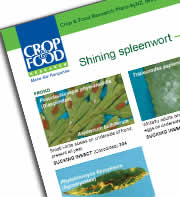|
|
Host plant
What is a host plant?
One question frequently asked is why are some plants attacked
by a herbivore and other plants left untouched. Within this simple
question are two linked questions,
- why are some plant species host plants?
- why are some plants within a host plant species
infested, while
other plants of the same species remain uninfested?
The Plant-SyNZ™ database is concerned with documenting the host
plants of herbivores and this information may give clues as to
why some plant species are hosts and others are not.
For the Plant-SyNZ™ database, a host plant is a plant species
on which at least one life stage of a herbivore feeds without being
harmed and can pass on to the next life stage or lay fertile eggs.
For an explanation of the criteria used to decide if a plant is
a host for a herbivore, go to the page explaining the use of a
reliability index for the quality
of this information. A more detailed
discussion about criteria used for deciding if a plant species
is a host of a herbivore can be found in the following paper: Ward
LK. 1988. The validity and interpretation of insect food plant
records. British Journal of Entomology and Natural History 1 (4)
: 153-162.
The database only shows whether a plant can be a host for a herbivore,
it does not provide information on the relative abundance of a
herbivore on different host plant species. All host plants listed
for a herbivore are not equally good hosts, e.g. leaf mines of Chromatomyia
syngenesiae (Diptera: Agromyzidae) are commonly seen on Sonchus species, Senecio
bipinnatisectus and S. jacobaea (ragwort), but, are
rarely seen on Senecio vulgar (groundsel) or S. skirrhodon.
Why are some plants of a host plant
species infested and others are not?
Herbivore numbers can change during the year because of the breeding
cycle of the herbivore, but infestation rates can also vary between
plants at a similar stage of the herbivore's annual cycle.
There are four main reasons for variable infestation of plants
by herbivores, plant resistance, environment, natural enemies and
chance. On a local scale, without careful experimentation it can
be very difficult to determine the relative importance of each
of these factors.
- Plant genotype, i.e. plant resistance.
The genetic variation of plants in a species may make some plants
more or less susceptible to the herbivore. Those on which the
herbivore cannot live or breed are called resistant. Resistance
may be due to the plant being toxic (poisonous) to the herbivore
or if the herbivore feeds on a particular growth stage, e.g. flowers,
they may not be available at the normal time for the plant species
and therefore miss attack by the herbivore. Plant breeders exploit
naturally occurring genetic resistance in plants to breed crops
that are resistant to pests and diseases.
- Environment. The environment in which a plant
grows or even part of a plant can affect its suitability as a
host for a herbivore.
- The climate in part of the plants geographic
range may not be suitable for the herbivore. This may be due
to temperature or humidity preferences, though often the precise
reason for restricted distribution is not known, e.g. Rastrococcus namartini (Hemiptera:
Pseudococcidae), a mealybug that lives on leaves of the tree, Myrsine
australis, is found on trees in the drier Central and
Eastern areas of Auckland Region, but is not found in the wetter
rainforest of the Waitakere Ranges.
- The weather can also affect the abundance
of herbivores on their host plants, either creating a short term
environmental change that favours or suppresses herbivore populations. Fluctuations in populations from year to year may be due directly
or indirectly to the weather and may be mediated through the
plants or by the activities of natural enemies. There are few
studies of the long term natural changes in abundance of New
Zealand indigenous herbivores.
- The growing media, soil and rock substrate on
which a plant is growing, may affect access to water and nutrients
and as a result the quality of plant tissues, which in turn may
make a plant more or less suitable as a host plant for a herbivore.
These effects may be very localised.
- Another factor, local environment can
also affect the suitability of plants as host for herbivores.
For example exposure to wind or frost may make plants less suitable
than those in protected sites. On the other hand, plants on
the edge of forest appear to more susceptible to some scale insects,
e.g. Icerya purchasi (Hemiptera:
Margarodidae). It also appears that location of leaves or twigs
on a tree can affect susceptibility to a herbivore. For example,
tree or shrub leaves in shady positions seem more likely to be
infested by some herbivores than leaves in full sun.
- Natural enemies. Pathogens, predators and
parasites can all attack and kill herbivores. They are one factor
that can reduce herbivore populations. This is the assumption
on which biological control research is based. When populations
of herbivores are reduced by natural enemies, then fewer plants
a likely to be infested, and the chance that a particular plant
will be infested is less.
- Chance. Even when a group of plants are equally
susceptible to a herbivore species, an individual herbivore still
has to find a plant. There is always an element of chance about
which plant is found and which is missed.
Contacts/Feedback
 |
PDFs can be viewed
using Adobe Reader. |
|


